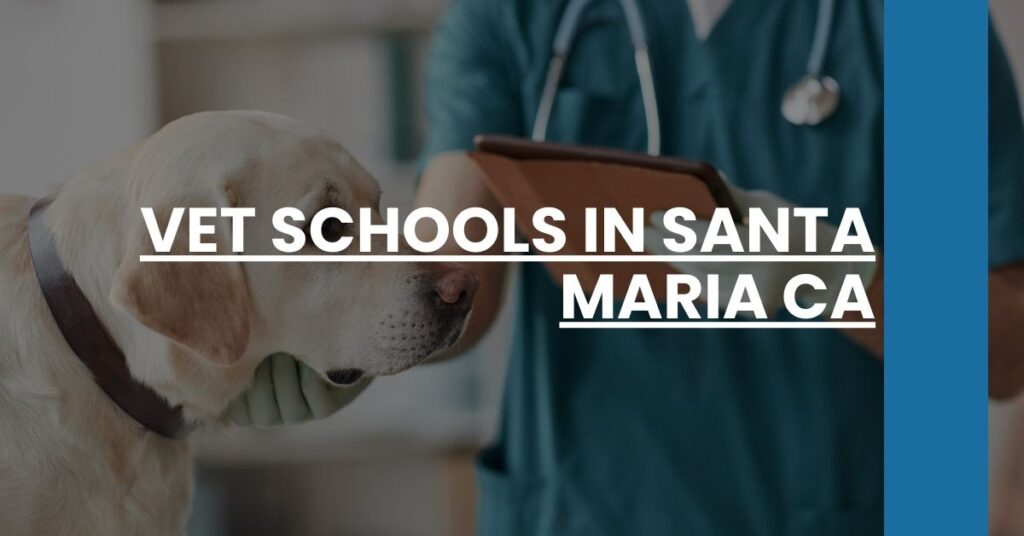Not in Santa Maria? Check out our lists of Vet Schools in Simi Valley, Stockton, Sunnyvale, Temecula, Thousand Oaks, Torrance, Vacaville, Vallejo, Victorville, and across California.
Best Vet Schools in Santa Maria CA
Looking for the best vet schools in Santa Maria, CA? We’ve got you covered. This article outlines top-rated programs, detailing their unique advantages and offerings to help you make an informed choice.
Whether you’re seeking hands-on experience, excellent faculty, or strong support services, these schools stand out for aspiring veterinarians.
University of California Santa Barbara – Pre-Veterinary Medicine Track
The University of California Santa Barbara (UCSB) offers a robust pre-veterinary medicine track tailored to set you on the path to a veterinary career. This track provides the necessary guidance and resources that help satisfy prerequisites needed by many veterinary schools.
Key Features:
- Introductory Biology Labs: UCSB has restructured its introductory biology labs into two 1.5 unit labs. Typically taken in the winter and spring quarters, these labs are crucial for your foundational knowledge.
- Customized Completion Options: If you’ve partially completed the previous lab series, UCSB’s Biology department offers pathways to finalize your requirements, ensuring nothing holds you back.
- Physics and Biochemistry Requirements: Many veterinary schools require a full year of physics with lab, which UCSB fulfills with the Physics 6 series. For some, additional physics courses may be necessary if you have taken the PHYSICS 1 series. The biochemistry course requirements may also vary and UCSB advises taking extra upper-division science courses to enhance competitiveness.
- GRE Preparation: Early preparation for the GRE is essential. This program emphasizes a thorough review of your academic transcript, including considerations like course retakes and withdrawals.
Why Choose UCSB:
UCSB’s pre-veterinary medicine track equips you with a solid foundation needed for future veterinary school applications. Even though UCSB does not have its own veterinary school, its resources and curriculum are designed to help you meet the criteria set by accredited veterinary schools.
For more information about their pre-veterinary medicine program, visit UCSB’s official page.
Allan Hancock College – Veterinary Technology Program
The Veterinary Technology Program at Allan Hancock College in Santa Maria is crafted to prep you for a thriving career as a veterinary assistant or registered veterinary technician.
Key Features:
- Hands-on Skills: You’ll learn key skills such as surgical assistance, anesthesia, digital imaging, dental processes, medical nursing, emergency care, and veterinary office practices.
- Comprehensive Curriculum: The program covers laboratory procedures, animal disease assessment, causes, prevention, and treatments.
- Valuable Partnerships: Connecting with local veterinarians for hands-on experience and internship opportunities is a significant advantage of this program.
- Educational Requirement Compliance: The program meets the educational standards set by the California Veterinary Medical Board, aiding in certification preparations.
Why Choose Allan Hancock College:
The program’s extensive hands-on training and detailed coursework are meticulously designed for real-world veterinary practices. While the admission is selective, successful graduates will earn a Certificate of Achievement, gearing them up for a successful career.
For more details on their veterinary technology program, visit Allan Hancock College’s official page.
How to Choose the Best Veterinary School in Santa Maria CA
Choosing the best veterinary school in Santa Maria, CA, involves considering several essential factors to ensure you receive the finest educational experience.
Steps to Consider:
- Accreditation:
- Ensure the school is accredited by recognized bodies such as the American Veterinary Medical Association (AVMA).
- Program Curriculum:
- Investigate if the curriculum covers essential areas like pharmacology, surgery, radiology, and clinical pathology. Look for a balance between theoretical knowledge and practical skills.
- Hands-On Training:
- Seek out programs offering robust partnerships with local veterinary practices, providing internship and externship opportunities.
- Faculty Expertise:
- Research the credentials and experience of faculty members. Educators with extensive field experience and advanced degrees add significant value to your education.
- Student Support Services:
- Evaluate available support services, such as academic advising, career counseling, and internship placement assistance, which can enhance your educational journey.
- Cost and Financial Aid:
- Factor in program costs and the availability of scholarships, grants, and financial aid.
- Class Size:
- Smaller class sizes generally offer more personalized instruction and better access to faculty, improving learning experiences.
- Location and Facilities:
- Consider the convenience of the school’s location, quality of campus facilities, and availability of modern labs and libraries.
By carefully assessing these factors, you can find the veterinary school that aligns best with your career goals and personal needs, ensuring a strong start in veterinary medicine.
Conclusion
Exploring vet schools in Santa Maria, CA has never been easier with detailed insights into the University of California Santa Barbara’s pre-veterinary medicine track and Allan Hancock College’s Veterinary Technology Program. These programs offer comprehensive education, hands-on experiences, and valuable partnerships that prepare you for a successful veterinary career.
Be sure to visit their websites for UCSB and Allan Hancock College for more details on how to enroll and kickstart your veterinary journey.
Allan Hancock College – Veterinary Technician Program
Allan Hancock College in Santa Maria offers a reputable Veterinary Technician Program. This program allows you to gain the necessary skills and knowledge for a career in veterinary medicine.
Key Features
- Extensive Training: The program includes animal anatomy and physiology, pharmacology, radiology, surgical nursing, and laboratory techniques.
- Hands-On Experience: Get valuable hands-on experience working with animals in realistic settings, preparing you for daily scenarios in veterinary practices.
- Cost-Effective: Compared to other veterinary technician programs, this program offers affordable tuition, making it accessible for many students.
- Flexible Scheduling: Options for part-time attendance allow you to manage your studies alongside other commitments.
Admission and Outcomes
Admission to Allan Hancock College’s Veterinary Technician Program is competitive. Meeting prerequisites and submitting a strong application is essential. Graduates of this program are well-equipped for various roles in veterinary practices, benefitting from a robust curriculum and practical training.
Find out more about the Veterinary Technician Program at Allan Hancock College.
How to Choose the Best Veterinary School in Santa Maria CA
Choosing the best veterinary school is crucial for your career in veterinary medicine. Here’s a guide to help you make an informed decision:
- Accreditation:
Ensure the school is accredited. Accreditation by recognized bodies, such as the American Veterinary Medical Association (AVMA), implies high educational standards. - Program Curriculum:
Check if the curriculum includes essential areas like pharmacology, surgery, radiology, and clinical pathology. A balance between theory and practical skills is crucial. - Hands-On Training:
Prioritize programs offering substantial hands-on training. Strong partnerships with local veterinary practices for internships are highly beneficial. - Faculty Expertise:
Research the qualifications and experience of faculty members. Experienced educators provide valuable insights and mentorship. - Student Support Services:
Evaluate the support services available, such as academic advising, career counseling, and internship placement assistance. These services enhance your educational journey and career prospects. - Cost and Financial Aid:
Consider program costs and the availability of scholarships, grants, and financial aid. It’s essential to ensure the program fits within your budget while offering quality education. - Class Size:
Smaller class sizes offer more personalized instruction and better faculty access, enhancing learning outcomes. - Location and Facilities:
Consider the convenience of the school’s location and the quality of campus facilities. Modern labs and libraries are pivotal to your learning experience.
Choosing the right veterinary school involves thoughtful consideration of these elements. Researching thoroughly helps ensure you select a program aligned with your career goals and personal needs.
Conclusion
Exploring vet schools in Santa Maria, CA, is a significant step in your educational journey. With detailed insights into the University of California Santa Barbara’s pre-veterinary medicine track and Allan Hancock College’s Veterinary Technology and Technician programs, you’re well-equipped to make an informed decision.
Both programs offer comprehensive education, practical hands-on experiences, and valuable partnerships that prepare you well for a thriving career in veterinary medicine. For more details, visit UCSB’s pre-veterinary medicine track page and Allan Hancock College’s Veterinary Technology Program page.
By carefully evaluating these options and considering factors like accreditation, curriculum, hands-on training, and support services, you can find the program that best fits your aspirations. Your journey to becoming a veterinary professional starts with choosing the right school in Santa Maria, CA.

